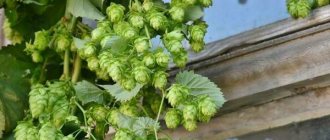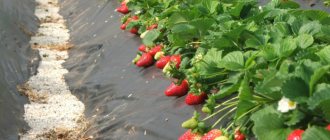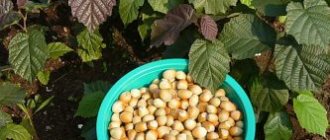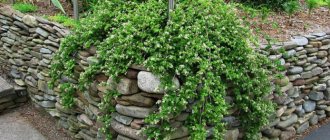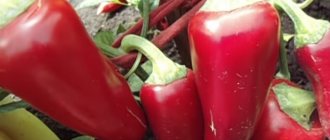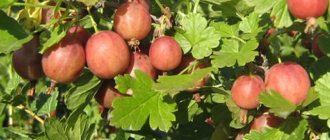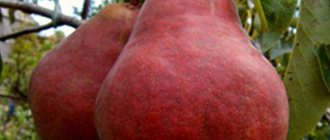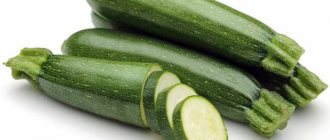History of the variety's creation
The Belozerka variety of bell pepper was created by breeders in one of the regions of Moldova - Transnistria.
Work on developing a new variety was carried out in the middle of the last quarter of the last century, and several other varieties of this vegetable crop were crossed.
Photo of Belozerka pepper
By creating a new variety, Moldovan breeders sought to develop a vegetable crop that would be characterized by increased resistance to various diseases, and would also have large ripe fruits and good yield in general, and could also be grown not only in garden beds, but also in greenhouse conditions.
And the Belozerka variety fully meets the objectives. Belozerka pepper was registered in the Russian State Register in 1995 and recommended for cultivation throughout almost the entire country.
Belozerka sweet pepper. Brief overview, description of characteristics - video
Fruits and yield
Belozerka produces cone-shaped fruits with elastic and juicy pulp. The surface of the fruit is glossy, smooth, the apex is slightly pointed. The fruits have several sides. The wall thickness is 4-7 mm.
The peppers themselves are average in weight and size - the weight of one fruit is 80-90 g.
The yield of the variety is high - during the season you can get up to 9 kg of vegetables from 1 sq. m.
The color of ripe fruits is bright red. They are stored for a long time and do not lose their beneficial and tasteful qualities.
This is a universal vegetable crop that is used both for canning and for daily cooking of various dishes:
- lecho;
- salads;
- soups;
- stuffing;
- adzhiki.
On a note. Bell pepper is rich in vitamin C; its regular use helps improve immunity, cleanses blood vessels, increases appetite, and normalizes blood counts.
Sweet pepper Belozerka - description of the variety
This pepper is mid-season in terms of ripening,
when grown in greenhouse conditions, the first fruits are harvested already 4 months after germination of the planting material, and in the garden beds, harvesting begins a little later. Peppers should be collected as they ripen.
Photo of bushes with Belozerka peppers
Belozerka pepper belongs to the determinant type,
therefore, the growth of the central shoot is limited. As a result, the bushes rarely grow more than 0.7 m in height. They are compact in width, not spreading, with strong and strong well-leafed shoots. The foliage is elongated, with sharp tips, glossy, dark emerald in color.
These low plants do not require staking and bush formation.
THE BEST VARIETIES OF PEPPERS!
Viking pepper Yellow Bell pepper Bogatyr pepper
The flowers are small in size, shaped like small stars, the color of the petals is white.
The roots of peppers of this variety are well developed.
This variety of sweet pepper is self-pollinating,
but it is better to plant other varieties of this vegetable crop nearby and not to thicken the plantings too much so that pollinating insects have free access to the flowers.
Diseases and pests
Treatment with special solutions against pests or diseases is carried out only when necessary. Plants are carefully inspected for damage to fruits or leaves. It is important to determine the real cause of the lesion in order to select an effective method of control.
The Belozerka pepper variety is resistant to blossom end, dry and wet rot, alternative, verticillium and viral diseases. Spraying with chemicals for diseases or pests is rarely necessary.
Main characteristics of Belozerka bell pepper
The fruits of this pepper can ripen of medium size or quite large - their weight usually ranges from 85 to 145 g. The size and number of ovaries formed are significantly influenced by weather conditions.
Cone-shaped fruits can be up to 13-15 cm or more in length. The base of ripe fruits is wider than the tip - sharp and slightly elongated.
Belozerka peppers that begin to ripen have a smooth, even surface coloring dark green; when the fruits are ripe, their color can be different - greenish with a white tint, red, orange or yellow.
The walls of ripe fruits of this variety are thin - no more than 0.7 cm, the pulp is juicy with a slight crunch, quite sweet and tasty. The taste of Belozerka pepper is excellent.
Belozerka pepper - features of planting and growing the variety - video
The fruit contains a large amount of ascorbic acid,
which are the main nutritional and healing aspects of this vegetable.
On a note!
If bell pepper is constantly present in a person’s diet, then people’s immune system is strengthened, blood vessels and walls are cleansed of “bad” cholesterol, blood composition becomes better, and appetite improves.
The harvested Belozerka pepper tolerates transportation well in different conditions and can be stored in the refrigerator for quite a long time. Also, all ripe fruits are of universal use:
they can be eaten fresh, added to various salads and snacks, used in the preparation of hot first and second courses, and also made into various preparations for the winter and frozen.
Characteristics and features
The bushes of this variety are characterized by the following features:
- semi-standard and spreading structure;
- height 40-80 cm;
- a large amount of foliage;
- number of fruits - 5-10 pieces;
- white or green flowers;
- Fruit ripening period is 110-115 days before technical maturity and 140-145 days before biological maturity.
The fruits have the following characteristics:
- with technical ripeness it is yellow, with biological ripeness it is red;
- length 15 cm;
- correct cone shape;
- hollow structure;
- wall thickness 5-7 mm;
- juicy pulp;
- sweet taste with a slight pungency;
- long shelf life and good transportability.
At the stage of technical ripeness, the fruits have a yellowish tint; at biological ripeness, they are red.
Advantages and disadvantages
The main advantages of Belozerka bell pepper include:
- high productivity;
- possibility of growing in greenhouses and garden beds;
- good resistance of this plant to most diseases;
- versatility of ripe fruits;
- the variety can be grown almost throughout Russia, but in more northern regions they should be planted in heated greenhouses in order to have time to fully harvest ripe peppers during the season;
- The harvested crop is characterized by good transportability and keeping quality.
There were no deficiencies noted in the Belozerka bell pepper.
Landing in the ground
The Belozerka pepper is transplanted into open ground when the weather is good. In central Russia this is approximately the end of May - beginning of June. The average daily temperature should be at least 18°C. Pepper does not like clay soil. Peat and humus must be added to the beds. Between the rows there should be at least 50 cm, between the holes - 40 cm. The depth of the holes should be such that the entire root system fits, and the neck is located at soil level. If desired, you can add phosphorus, nitrogen, and potassium to the well.
Landing rules:
- Carefully remove the plant from the pot with a lump of earth.
- Place in a prepared and watered hole.
- Sprinkle with earth.
- Compact.
- Pour over warm, settled water.
You can grow Belozerka sweet peppers in many regions of the country. In the southern regions it can grow in open ground; in more northern regions it will thrive in greenhouses.
Belozerka pepper: growing, planting and care
This variety of bell pepper should be planted in seedlings.
Seeds for further planting are usually purchased at garden stores.
Purchased seeds should be soaked in a growth stimulant solution before planting for germination and rapid germination.
Preparing soil and containers for planting
For growing Belozerka bell peppers, purchased soil for vegetable seedlings is quite suitable. It contains all the necessary fertilizers for the active growth of pepper seedlings.
But some vegetable growers prepare a nutrient mixture on their own; for this they mix leaf and turf soil, to which they add river sand and a little wood ash. Home-prepared soil must be spilled with a weak solution of potassium permanganate to disinfect it before placing it in containers.
Photo of preparing soil and containers for pepper seedlings
If the containers in which bell pepper seedlings will be grown have previously been used for growing plants, they should also be disinfected with potassium permanganate or Bordeaux mixture.
Then a nutrient substrate is poured into the containers, which is moistened with water, and then grooves are made in it 1 cm deep and at a distance of 3 cm from each other, the seeds are laid out in them, sprinkled with earth, covered with polyethylene and placed in a dark place with an air temperature not less than 23-24 degrees Celsius.
Belozerka pepper seeds are sown for seedlings in the last ten days of February.
Hot pepper - varieties for open ground!
The best varieties of hot peppers for open ground and home cultivation
Caring for Belozerka pepper seedlings
After the first shoots appear (about 7-10 days after planting), the polyethylene is removed and the containers are moved to a bright place. For normal growth and development, seedlings require 12 hours of daylight; if there is not enough lighting, then phytolamps are placed next to the plants to provide additional illumination to the plants.
Seedlings should be watered 2-3 times a week; usually watering is done using a spray bottle. Water for irrigation should be settled and warm (room temperature).
INTERESTING ARTICLE:
Fertilizing pepper seedlings at home
When 2-3 true leaves appear on the seedlings, they should be picked into separate cups. 12-14 days after picking Belozerka peppers, you can begin feeding the plants with special fertilizers for seedlings of vegetable plants.
On a note!
During the period of growing bell pepper seedlings, they should be fed at least 2 times.
Approximately 12-14 days before transplanting seedlings to a permanent place, the hardening procedure of young plants should begin. To do this, they are taken out onto the balcony or loggia, gradually increasing the time they spend “outside”.
Transplanting pepper seedlings to a permanent place
When the first buds appear on the grown seedlings, it is time to plant them in a permanent place:
- Belozerka bell pepper seedlings are planted in greenhouses in the second ten days of May;
- Strong seedlings can be transplanted into garden beds at the end of May, when the threat of spring return frosts has passed.
The beds for this vegetable crop should be prepared in advance - cleared of remnants of vegetation, added organic matter and mineral fertilizers, dug up the soil and loosened it.
The distance between adjacent plants in rows should be 0.4 m, and the depth of the holes should be no more than 20 cm.
Place a little humus and wood ash on the bottom of each hole.
One plant at a time is placed in the prepared holes, sprinkled with soil and carefully compacted.
INTERESTING TO KNOW!
The best varieties of sweet peppers for open ground
Harvest and storage
There are two ways to harvest:
- The first is suitable for those who plan to use the peppers right away. For example, for cooking or homemade winter preparations. Harvesting occurs when the fruits reach biological maturity, when the peel acquires a characteristic scarlet or yellow tint.
- The second option is ideal for transporting fruits over long distances or for long-term storage for later use. In this case, the harvest is harvested when the fruits reach technical maturity.
Harvest peppers using pruning shears or scissors, cutting off the fruit and stem. Send peppers for storage without scratches, dents or other mechanical damage.
For large volumes, for better preservation of peppers, wrap them in paper napkins and place them in wooden boxes. This way they can last throughout the winter months. Check the peppers occasionally for rot and remove any damaged fruit if necessary.
Another good method for storing this vegetable is freezing. However, all peppers must be ripe. Rinse the vegetables in cool water and pat dry with a towel to remove excess moisture. Then remove the stalk and seed part. Cut the peppers into strips or cubes. Pack the cuts into plastic bags or food containers and place them in the freezer.
Further care for Belozerka peppers
Caring for this vegetable crop is simple: you need to carry out regular watering, apply fertilizing, and loosen the root zone.
Caring for peppers in a greenhouse during flowering - video
Watering and loosening the soil
Pepper bushes transplanted to a permanent location should be watered once every 3-4 days. In dry weather, the amount of watering is increased, and in rainy weather, reduced.
After each watering, the soil in the root zone of the pepper bushes should be loosened to remove the dry crust that appears on the soil surface. At the same time, all weeds are removed.
GOOD VARIETIES OF PEPPERS!
Pepper Oriole Sweet pepper Player Hot pepper Bell
Feeding
For better fruiting, Belozerka pepper bushes should be fed several times a season:
- a couple of weeks after transplantation to a permanent place;
- before flowering begins;
- after flowering ends;
- during the period of fruit ripening, but no later than 12-14 days before harvest.
Mineral fertilizers containing phosphorus and potassium are applied to this vegetable crop.
Photo of Belozerka pepper fruits inside
Germination of seeds
Each plant is placed in a separate container - then it is easier to transplant them into open ground
At this stage, it is important to provide the seedlings with good lighting and watering (do not allow the soil to dry out)
Feeding
The crop is fed with a small amount of superphosphate and potash fertilizers immediately after the cotyledon leaves appear. The second feeding is done when more than ten true leaves are formed and the pepper reaches 10 cm in height.
To do this, use chemical compositions at the rate of 15 g of superphosphate and 5 g of potassium per 5 liters of liquid at room temperature. The specified proportions must be strictly observed, otherwise the crop will be oversaturated with nitrates.
During the formation of the ovary and flowering, the first feeding is performed, the second - when the fruits ripen.
Pepper Belozerka: reviews from those who planted
Natalya, 45 years old, Moscow region: I grow bell peppers on my plot exclusively in a greenhouse - there these heat-loving plants do not suffer from changes in air temperature, develop faster and bear fruit better. Last year I planted a bed of Belozerka peppers as a test. I really liked this pepper - it practically did not hurt me, only once an aphid settled on it, which I quickly removed. The fruits are quite large, beautiful and very tasty. From one square of area I collected about 8 kg of ripe peppers, and this is a very good yield. I will grow this variety in the future.
Svetlana, 55 years old, Volgograd region: I have been growing Belozerka pepper on my plot for several seasons now. I liked the variety for its good yield and relative ease of care. The fruits tolerate transportation well and can be stored in the refrigerator for a long time. This is the second season I’ve been planting several beds with this pepper, and the harvest is enough for food, for canning, I even partially sell this pepper - they take it away from me quickly, because the fruits are beautiful and very tasty.
Belozerka pepper is one of the most popular varieties of this vegetable crop due to its high yield, resistance to most diseases and relative ease of care.
Cleaning and storage
Fruit harvesting can be carried out both in a state of technical (when the fruits are green) and biological (when the pepper acquires a rich red color) ripeness. In the first case, the shelf life increases almost one and a half times. The second option is more suitable when the fruits will be immediately eaten.
To get a good harvest, you need to use high-quality seeds. The most productive varieties are possible. Large selection of varieties for every taste.
Belozerka should be stored in a cool, dry place. It’s good if you have a cellar or pantry; if not, the bottom shelf of the refrigerator will do.
It is important! If you want to preserve the pepper longer, pick it with the stalk and be sure to carefully sort the fruit. “Belozerka” can also be frozen. After this, it practically does not lose its taste and benefits and helps, even in harsh winter, to prepare nourishing, vitamin-rich dishes with a rich aroma
After this, it practically does not lose its taste and benefits and helps, even in harsh winter, to prepare nourishing, vitamin-rich dishes with a rich aroma
“Belozerka” can also be frozen. After this, it practically does not lose its taste and benefits and helps, even in harsh winter, to prepare nourishing, vitamin-rich dishes with a rich aroma.
